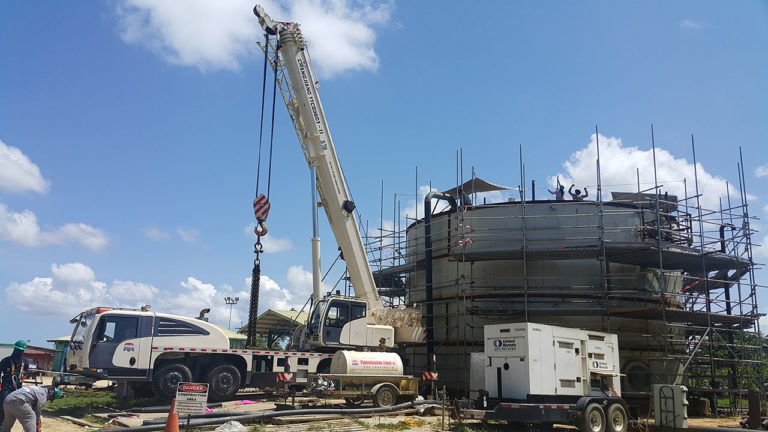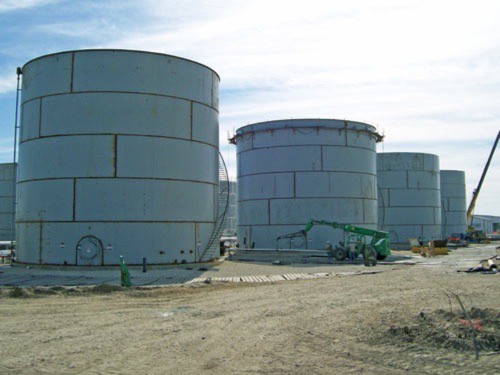How Welding Examination Functions: A Comprehensive Guide for Professionals
Welding assessment plays an important role in making sure the safety and security and dependability of welded structures. It entails a methodical technique that consists of both aesthetic examination and advanced testing techniques. Specialists need to familiarize themselves with vital criteria and laws regulating the sector. Understanding the typical issues that can arise during welding is crucial. This overview will certainly explore these elements carefully, providing insights into the procedures that promote high quality and integrity in welding.
Understanding the Relevance of Welding Assessment
While several may underestimate the relevance of welding assessment, it plays an essential role in ensuring the honesty and safety and security of welded frameworks. Effective welding assessment recognizes prospective flaws and defects that can jeopardize architectural toughness and lead to tragic failings. The inspection process incorporates numerous methods, such as aesthetic assessments, ultrasonic testing, and radiographic evaluations, each adding to the overall analysis of weld quality.
Along with guarding the architectural honesty, welding examination guarantees conformity with sector standards and customer requirements. By making certain that welds meet called for resistances and characteristics, evaluations aid preserve the dependability and durability of parts in numerous applications, from building to aerospace. In addition, an extensive inspection process fosters a culture of high quality and accountability amongst producers and welders. Ultimately, welding evaluation is not just a step-by-step step; it is an essential technique that underpins the safety and security and performance of engineered systems across varied fields.
Trick Standards and Rules in Welding Assessment
The structure of effective welding examination hinges on adherence to developed criteria and regulations. Various organizations, such as the American Welding Society (AWS) and the American National Specification Institute (ANSI), stated guidelines that guarantee high quality and security in welding methods. Trick requirements, such as AWS D1.1 for structural welding and ASME Area IX for stress vessels, provide comprehensive requirements for welding assessments, treatments, and qualifications. Regulative frameworks, including those from the Occupational Security and Health And Wellness Management (OSHA), required safety and security methods and worker protections in welding environments. Conformity with these requirements is crucial for attaining consistent weld quality and lessening the threat of failures. In addition, international standards like ISO 3834 additionally enhance worldwide consistency in welding assessment techniques. Professionals have to stay informed about these laws to guarantee that their assessment methods line up with sector expectations and legal needs, thus guarding both workers and structural honesty.
Preliminary Prep Work and Visual Assessment Techniques

Efficient welding evaluation starts with a detailed pre-inspection checklist that assures all required problems are fulfilled prior to the actual inspection takes area. Following this preparation, visual issue recognition plays an important duty in reviewing weld quality, allowing inspectors to find problems such as cracks or incorrect fusion. Together, these techniques develop the foundation for an effective welding evaluation procedure.
Pre-Inspection Checklist
Before starting any type of welding assessment, an extensive pre-inspection list is necessary to guarantee that all necessary prep work are completed which aesthetic assessment methods are effectively used. Trick components of this list consist of confirming the welding procedure requirements (WPS), ensuring all tools is calibrated and in good working problem, and verifying that the examiner has the required qualifications. In addition, it is vital to examine any type of previous examination reports and to analyze the work environment for security threats. The examiner must also validate that all relevant paperwork, such as product certifications and examination records, is easily offered. Finishing this list aids to establish a solid foundation for an effective inspection procedure, boosting the reliability of the results gotten.
Aesthetic Defect Identification
A successful visual defect recognition procedure starts with careful initial preparation and the application of established visual inspection strategies. Examiners need to assure that the welding area is well-lit pop over here and clean, as adequate exposure is vital for discovering problems. A thorough assessment of the weld joint's surface area enables for the recognition of suspensions, such as cracks, damages, or porosity. Examiners often utilize devices like amplifying glasses or mirrors to enhance their view of hard-to-reach areas. Additionally, they must know with the particular welding requirements and guidelines relevant to the task. By adhering to these approaches, assessors can efficiently determine possible concerns, safeguarding the stability of the weld and compliance with industry standards.
Non-Destructive Testing Techniques: An Overview
Non-destructive testing (NDT) techniques play an important duty in the welding evaluation procedure by guaranteeing the honesty and reliability of bonded frameworks without causing any damages (API 650 Welding Inspection). These strategies permit assessors to examine the high quality of welds while protecting the components being taken a look at. Common NDT techniques consist of ultrasonic testing, radiographic testing, magnetic fragment screening, and dye penetrant testing, each offering one-of-a-kind benefits
Ultrasonic screening utilizes high-frequency acoustic waves to find internal flaws, while radiographic testing makes use of X-rays or gamma rays to visualize the internal framework of welds. Magnetic fragment screening discloses surface and near-surface problems by applying an electromagnetic field and iron particles to the weld area. Color penetrant screening highlights surface-breaking imperfections through the application of a colored dye. With each other, these NDT techniques provide vital understandings right into weld top quality, allowing experts to make educated choices relating to security and conformity in welding applications.
Typical Flaws and Their Implications
Recognizing usual flaws in welded joints is important for maintaining architectural stability and security. Various flaws can develop during the welding process, each lugging prospective implications for the total performance of the structure. Porosity, identified by little gas pockets within the weld, can weaken the joint and endanger its load-bearing capability. Cracks might develop as a result of thermal anxiety or improper air conditioning, causing potential failure under stress. Insufficient fusion occurs when the weld metal does not fully bond with the base product, resulting in weak joints that might not endure intended tons. Undercutting, where the base metal is deteriorated, can additionally decrease the efficient cross-section of the weld. Additionally, extreme reinforcement can produce stress concentrations that can lead to failing. Recognizing these issues quickly allows for restorative you could try these out actions, guaranteeing the longevity and integrity of bonded structures in critical applications.
Tools and Tools Used in Welding Assessment
Reliable welding evaluation counts on a selection of specialized tools and devices to guarantee the quality and integrity of welded joints. Essential tools consist of visual inspection tools, such as amplifying borescopes and glasses, which permit inspectors to carefully check out welds for surface problems. Non-destructive testing (NDT) techniques, such as ultrasonic screening, radiographic screening, and magnetic fragment testing, are basic for identifying internal flaws without damaging the material.
Measurement tools, including calipers and Check Out Your URL weld determines, help evaluate measurements and determine compliance with specs. In addition, hardness testers assess the mechanical buildings of welded joints. Individual safety equipment (PPE) is likewise essential, protecting the safety and security of inspectors while functioning in potentially unsafe environments (API 650 Welding Inspection). Each tool serves a certain purpose, collectively improving the performance of welding examination and adding to the dependability of completed tasks
Often Asked Concerns
What Credentials Are Required to Come To Be a Welding Inspector?
To become a welding examiner, individuals commonly require pertinent certifications, such as AWS CWI or CSWIP, along with experience in welding processes, engineering concepts, and expertise of examination strategies, safety and security criteria, and suitable codes.
Just How Commonly Should Welding Inspections Be Carried Out?
Welding evaluations need to be performed routinely, ideally at various project phases, including pre-weld, during-weld, and post-weld. Frequency may additionally rely on market requirements, project requirements, and the intricacy of the welds entailed.
Can Welding Defects Be Repaired After Examination?

Yes, welding problems can frequently be repaired after examination. Relying on the extent and sort of flaw, suitable methods such as reworking or added welding may be utilized to recover structural integrity and safety conformity.
What Industries Require Normal Welding Examinations?

Numerous markets, including building and construction, manufacturing, aerospace, and auto, need regular welding assessments - API 650 Welding Inspection. These examinations assure adherence to safety standards and high quality control, decreasing risks connected with structural honesty and functional performance in bonded components
How Do I Pick a Welding Assessment Solution?
To select a welding examination service, one must consider certifications, experience, certifications, and industry reputation. Additionally, assessing consumer reviews and assuring the solution meets pertinent requirements can help ensure high quality examinations and trusted outcomes.

While many might take too lightly the relevance of welding evaluation, it plays a necessary duty in guaranteeing the stability and safety of bonded structures. Trick criteria, such as AWS D1.1 for structural welding and ASME Section IX for pressure vessels, give thorough criteria for welding qualifications, evaluations, and procedures. Reliable welding evaluation begins with a detailed pre-inspection list that guarantees all needed conditions are fulfilled before the real evaluation takes location. Prior to beginning any type of welding evaluation, a thorough pre-inspection list is important to guarantee that all required prep work are finished and that aesthetic examination techniques are properly employed. Non-destructive testing (NDT) approaches play a crucial role in the welding evaluation process by making sure the integrity and dependability of welded frameworks without creating any kind of damages.